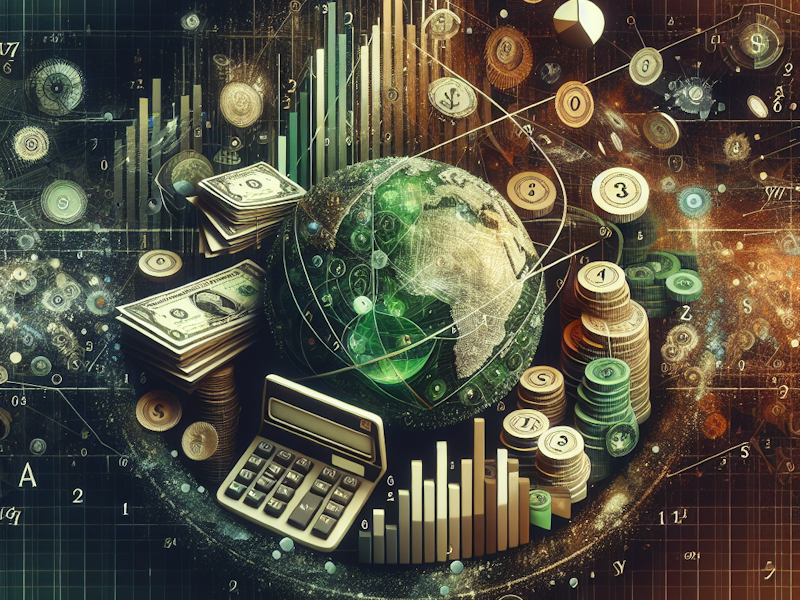The Evolution of Money
Welcome to Getslocal's exploration of The Evolution of Money: From Barter to Blockchain and Beyond. Money, in its many forms, has shaped economies, cultures, and societies throughout history. From the earliest days of barter in primitive communities to the cutting-edge world of cryptocurrencies and blockchain technology, the journey of money reflects humanity's endless innovation and adaptation. Join us as we trace the fascinating transformation of money across millennia, examining its role in trade, power, and the future of global finance. Discover how each era contributed to the complex financial landscape we navigate today, and envision where the next frontier might lead.
Stone Age
Caveman Barter (Prehistoric Times to Present day)
In the earliest stages of human society, before the invention of currency, people engaged in direct trade, or barter, to acquire the goods and services they needed. A caveman might trade a sharpened tool for animal skins or food. This system was based on the mutual needs of the parties involved, but it was limited by the "double coincidence of wants," where both parties had to have something the other wanted.
Agrarian Societies
The Emergence of Commodity Money (Circa 9000 BCE)
As societies began to form around agriculture, the limitations of barter became apparent. Early agrarian communities started to use commodities like grain, cattle, and shells as a form of money. These items had intrinsic value and could be easily exchanged for other goods, laying the groundwork for more sophisticated economic systems.
Bronze Age
Tablets of Ancient Persia (Circa 3000 BCE)
With the development of writing, early civilizations such as the Sumerians and Persians began recording economic transactions on clay tablets. These records documented the exchange of goods, payments of taxes, and debts. The use of these tablets marked a significant advancement in the evolution of money, as it allowed for the formalization and tracking of financial obligations.
Iron Age:
Gold and Romans to the Crusaders (Circa 1500 BCE to 1000 CE)
During the Iron Age, the use of metals, particularly gold and silver, became increasingly common as a medium of exchange. Gold coins were used extensively throughout the Roman Empire, symbolizing wealth and power. However, as emperors sought to expand their spending power, they began to debase the currency by reducing the precious metal content of their coins. For example, Emperor Nero (AD 54–AD 68) debased the Roman denarius to about 90 percent silver, while Emperor Trajan (AD 98–AD 117) further reduced it to about 85 percent silver. This practice allowed the emperors to increase the money supply, fund their military campaigns, and bolster their economies, but it also led to inflation and the eventual decline in the value of Roman currency. This practice continued with varying degrees of intensity throughout the Roman Empire and into the medieval period, influencing the financial practices of subsequent societies, including the Crusaders, who continued to rely on precious metals as a basis for their economies.
Classical Antiquity
The Birth of Coinage (Circa 600 BCE)
The first standardized coins were minted in Lydia (modern-day Turkey) around 600 BCE. These coins, made from electrum, a naturally occurring alloy of gold and silver, featured stamped designs that indicated their value. The introduction of coinage revolutionized trade by providing a reliable, consistent medium of exchange that could be widely accepted.
Chinese Han Dynasty
The Introduction of Paper Money (105 CE)
One of the most significant advancements in the history of money came during the Han Dynasty in China with the invention of paper. By 105 CE, the Chinese began to use paper notes as a form of currency, a practice that would eventually spread to other parts of the world. These early banknotes allowed for much easier and safer transportation of wealth, reducing the need to carry heavy metal coins.
Middle Ages
Tudor Tally Sticks (Circa 1100 to 1500 CE)
In medieval England, tally sticks were used as a form of record-keeping for debts and taxes. A stick was split in half, with each party retaining one half. The notches on the stick indicated the amount owed. Tally sticks were widely used by the Tudor monarchy, becoming a crucial part of the financial system. This method of recording transactions foreshadowed modern accounting practices.
Renaissance and Early Modern Period
The Rise of Banking (Circa 1400 to 1700 CE)
The Renaissance period saw the rise of banking institutions, particularly in Italy, where families like the Medici established banks that offered services such as loans, currency exchange, and safekeeping of valuables. The invention of bills of exchange allowed merchants to transfer money across long distances without the physical movement of coins, facilitating international trade and laying the foundation for modern banking.
Industrial Age
Victorian Central Banks (18th to 19th Century)
The Industrial Revolution brought about rapid economic expansion and the need for more organized financial systems. Central banks, such as the Bank of England, became pivotal in managing national currencies, regulating the supply of money, and ensuring economic stability. The gold standard was widely adopted, where currencies were backed by physical gold reserves, providing confidence in the value of money.
19TH CENTURY PRIVATE CURRENCY
Hard Times Tokens (1833–1843)
During the early 19th century, the United States faced significant economic hardship due to financial instability and a lack of official currency, leading to the emergence of Hard Times Tokens. Issued between 1833 and 1843, these tokens were created by private individuals and businesses as a response to the shortage of official coins and the impact of the economic depression that followed the Panic of 1837. These tokens, made from materials such as copper and brass, served as a local medium of exchange and were often used to facilitate transactions in the absence of a stable currency. They featured various designs and inscriptions, reflecting their issuers' names or local businesses. While initially practical, the use of Hard Times Tokens highlighted the growing need for a more reliable and standardized monetary system, setting the stage for future reforms in American currency and banking practices.
Early 20th Century
The Wir Bank and Mutual Credit (1934 Onwards)
During the Great Depression, Switzerland saw the creation of the Wir Bank, a mutual credit system designed to help businesses trade with one another without the need for traditional currency. Members of the Wir Bank could exchange goods and services using credits, a system that helped sustain the economy during times of financial crisis. This model of mutual credit has since inspired other forms of alternative currencies and exchange systems around the world.
Mid-20th Century
Green Shield Stamps and Loyalty Currency (1950s to 1970s)
The mid-20th century saw the rise of loyalty programs, with Green Shield Stamps being one of the earliest and most popular forms. Customers would collect stamps when they made purchases at participating retailers, which they could later redeem for various goods. This system introduced the concept of loyalty currency, where spending was rewarded with a type of private money that could only be used within a certain network.
Late 20th Century
Time Banks and LETS (1980s to Present)
In the 1980s, alternative currencies like Time Banks and Local Exchange Trading Systems (LETS) began to emerge. Time Banks allow people to trade hours of work, with each hour being valued equally regardless of the service provided. LETS, on the other hand, enable communities to trade goods and services using a locally created currency. These systems promote local economies and foster a sense of community by encouraging mutual aid and exchange.
Late 20th Century
Commercial Trade Exchange and Peer-to-Peer Mutual Credit (1970s to Present)
The late 20th century also saw the development of commercial trade exchanges, where businesses could trade goods and services using a system of credits rather than traditional money. These exchanges often operate as networks where businesses earn credits from their sales, which can then be spent on purchases from other members. This peer-to-peer mutual credit system allows companies to conserve cash and make better use of their surplus inventory or services.
20th Century
The Birth of Digital Money and Credit Cards (Mid to Late 20th Century)
The mid-20th century marked the beginning of the digital transformation of money. Credit cards were introduced, allowing consumers to make purchases without cash. This era also saw the development of electronic funds transfer systems, enabling money to move across the globe at the speed of light. Digital money became increasingly common, with bank accounts and transactions moving online.
THE RISE OF LOYALTY POINTS
Rise of Loyalty Points in Retail (1990s to Present)
As the retail landscape evolved, large supermarket chains like Tesco, Sainsbury's, Lidl, and others began to implement loyalty points programs to retain customers and encourage repeat purchases. These programs, such as Tesco's Clubcard and Sainsbury's Nectar, reward shoppers with points for each purchase, which can later be redeemed for discounts or special offers. These loyalty points effectively act as a secondary currency within the retail ecosystem, incentivizing customers to choose one retailer over another. The success of these programs has been immense, with billions of points issued and redeemed each year, shaping consumer behavior and deepening the relationship between retailers and their customers.
THE Rise of Premium Points
Rise of Premium Loyalty Programs (2000s to Present)
Building on the success of basic loyalty programs, companies like Amazon introduced premium loyalty programs, such as Amazon Prime. These programs require a subscription fee but offer significant perks, such as free shipping, exclusive discounts, and access to premium content. The rise of these premium loyalty programs reflects a shift in consumer expectations, where convenience and added value are highly prized. These programs have become a critical component of customer retention strategies for large corporations, driving long-term customer loyalty and generating consistent revenue streams.
21st Century CRYPTO CURRENCIES
The Hipster Crypto Revolution (2009 Onwards)
The launch of Bitcoin in 2009 ushered in the era of cryptocurrencies. These digital assets operate on decentralized blockchain technology, offering an alternative to traditional currencies and banking systems. Cryptocurrencies gained popularity among tech enthusiasts and those seeking financial independence from centralized institutions. The rise of Bitcoin, Ethereum, and other cryptocurrencies challenged the traditional financial system and introduced the concept of programmable money.
Gaming Currencies
Online Gamers’ Currencies and Their Impact (2000s to Present)
The rise of online gaming has given birth to a new form of currency: virtual in-game currencies. Games like World of Warcraft, Fortnite, and many others have created their own ecosystems where players can earn, buy, and trade virtual currencies. These currencies can be used to purchase in-game items, customize avatars, and enhance gameplay experiences. The impact of these currencies extends beyond the games themselves, with some players trading virtual goods for real-world money in secondary markets. The significance of online gamers' currencies lies in their ability to create entire virtual economies, where digital assets hold real value. These virtual currencies have blurred the lines between entertainment and finance, influencing how younger generations perceive and interact with money.
Present Day
The Age of Fintech and Digital Banking (2010s to Present)
The financial technology (fintech) revolution has transformed the way people manage money. Mobile banking apps, peer-to-peer payment systems, and robo-advisors have made financial services more accessible and efficient. The integration of AI and machine learning in finance has led to the development of sophisticated algorithms for trading, lending, and risk management. Digital wallets and contactless payments have become the norm in many parts of the world.
THE FUTURE OF CURRENCIES & AI Age
The Era of Robots and Intelligent Finance (The Future)
As we look to the future, artificial intelligence and robotics are expected to play an increasingly prominent role in the evolution of money. AI-driven financial systems will manage investments, conduct transactions, and even create new forms of digital currency autonomously. Robots may handle complex financial tasks with speed and precision, while blockchain technology could evolve to enable even more secure and transparent financial systems. The era of intelligent finance will redefine our relationship with money, blending human and machine decision-making in unprecedented ways.


